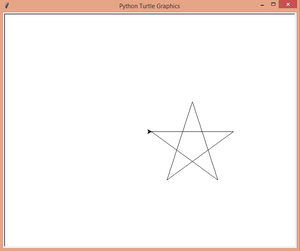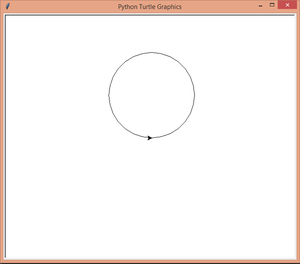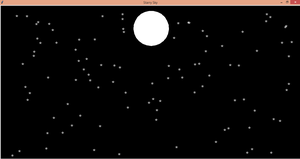Prerrequisitos: Programación Turtle en Python
En Python, Turtle es una biblioteca incorporada que nos permite dibujar diferentes patrones, formas o cualquier cosa que queramos, pero para eso, debemos ser conscientes de los usos de las diferentes funciones proporcionadas por la biblioteca Turtle.
En este artículo vamos a aprender a dibujar el cielo estrellado. Tal vez este artículo fue largo, pero después de leer el artículo completo, puede comprender todos y cada uno de los pasos fácilmente.
Para eso, estamos usando la biblioteca de turtle y el módulo aleatorio para generar posiciones aleatorias para dibujar las estrellas.
Los métodos que estamos usando para dibujar Starry Sky se enumeran a continuación.
| MÉTODO | PARÁMETRO | DESCRIPCIÓN |
|---|---|---|
| Tortuga() | Ninguna | Crea y devuelve un nuevo objeto Turtle. |
| bg color | nombre del color | llena el color en el fondo de la ventana |
| circulo() | radio, extensión, pasos | Dibuja un círculo con radio dado. |
| título() | nombre | Da nombre a la ventana de la Turtle. |
| adelante() / fd() | Monto | Mueve la Turtle hacia adelante en la cantidad especificada. |
| Pantalla() | Ninguna | Después de pasar este método, la pantalla de Turtle estará activa |
| velocidad | valor | Decide la velocidad de la pluma. |
| arriba() | Ninguna | Recoge la pluma de la Turtle. |
| abajo() | Ninguna | Recoge la pluma de la Turtle. |
| izquierda() | ángulo | Gira la Turtle en sentido contrario a las agujas del reloj. |
| Correcto() | ángulo | Gira la Turtle en el sentido de las agujas del reloj. |
| ir() | x, y | Mueve la Turtle a la posición x, y. |
| comenzar_llenar() | Ninguna | Llame justo antes de dibujar una forma para rellenar. Equivale a llenar (Verdadero). |
| end_fill() | Ninguna | Rellene la forma dibujada después de la última llamada a begin_fill(). Equivale a llenar (Falso). |
| ocultarTurtle() | Ninguna | Esconde la Turtle después de terminar el dibujo. |
| exitonclick() | Ninguna | Al hacer clic en salir de la pantalla de la Turtle. |
| al azar | valor inicial, final | Genera valores aleatorios dentro del rango dado. |
Nuestro Cielo Estrellado está formado por muchas Estrellas y con una Luna que tiene forma de Círculo. Entonces, primero tenemos que aprender a dibujar las estrellas y el círculo.
Primero aprendamos cómo dibujar la estrella a través de nuestro código.
Python
# importing turtle library import turtle # creating turtle object t = turtle.Turtle() # to activate turtle graphics screen w = turtle.Screen() # speed of turtle's pen t.speed(0) # creating star for i in range(0, 5): t.fd(200) t.right(144) # after clicking turtle graphics screen # will be terminated w.exitonclick()
Producción:
En el código anterior, ejecutamos el ciclo for del rango 0 a 5 porque, como todos sabíamos, la estrella tiene 5 aristas y el ángulo entre dos aristas será de 144 grados para hacer la estrella perfecta, eso es lo que estamos haciendo en la línea t.right (144) estamos moviendo la cabeza de la Turtle en un ángulo de 144 grados y la línea t.fd(200) decide el tamaño de nuestra estrella (menor valor = menor estrella)
Ahora, vamos a aprender a dibujar el Círculo a través de nuestro código.
Python
# importing turtle library import turtle # creating turtle object t = turtle.Turtle() # to activate turtle graphics Screen w = turtle.Screen() # speed of turtle's pen t.speed() # Creating circle t.circle(100) # after clicking turtle graphics screen # will be terminated w.exitonclick()
Producción:
En el código anterior, para hacer un círculo estamos usando la función de círculo proporcionada por la biblioteca de turtle, solo que pasamos el parámetro 100 que define el radio del círculo. Después de ejecutar nuestro código, obtenemos nuestro círculo.
Entonces, finalmente, habíamos aprendido a dibujar la estrella y el círculo.
Ahora vamos a dibujar nuestro Cielo Estrellado .
Python
# importing libraries
import turtle
import random
# creating turtle object
t = turtle.Turtle()
# to activate turtle graphics Screen
w = turtle.Screen()
# setting speed of turtle
t.speed(0)
# giving the background color of turtle
# graphics screen
w.bgcolor("black")
# giving the color of pen to our turtle
# for drawing
t.color("white")
# giving title to our turtle graphics window
w.title("Starry Sky")
# making function to draw the stars
def stars():
for i in range(5):
t.fd(10)
t.right(144)
# loop for making number of stars
for i in range(100):
# generating random integer values for x and y
x = random.randint(-640, 640)
y = random.randint(-330, 330)
# calling the function stars to draw the
# stars at random x,y value
stars()
# took up the turtle's pen
t.up()
# go at the x,y coordinate generated above
t.goto(x, y)
# took down the pen to draw
t.down()
# for making our moon tooking up the pen
t.up()
# going at the specific coordinated
t.goto(0, 170)
# took down the pen to start drawing
t.down()
# giving color to turtle's pen
t.color("white")
# start filling the color
t.begin_fill()
# making our moon
t.circle(80)
# stop filling the color
t.end_fill()
# after drawing hidding the turtle from
# the window
t.hideturtle()
# terminated the window after clicking
w.exitonclick()
Producción:

Cielo estrellado
En el código anterior, después de leer los comentarios antes de cada línea de código, comprenderá que tiene una idea clara de cómo funciona nuestro código y dibuja las estrellas estrelladas.
Publicación traducida automáticamente
Artículo escrito por srishivansh5404 y traducido por Barcelona Geeks. The original can be accessed here. Licence: CCBY-SA


